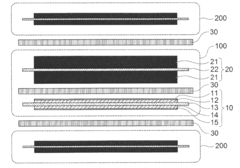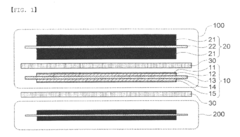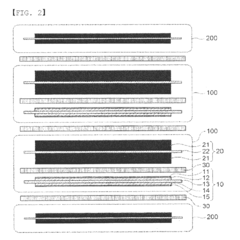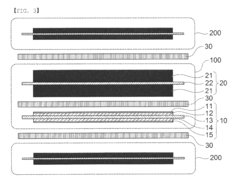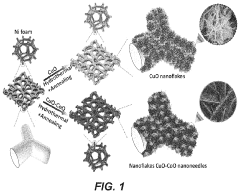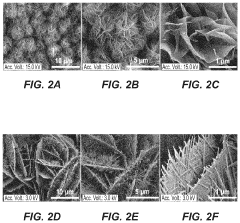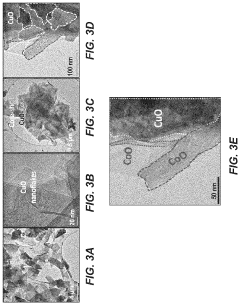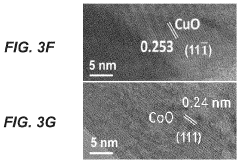Research on Hybrid Supercapacitor Patents in Emerging Markets
OCT 15, 202510 MIN READ
Generate Your Research Report Instantly with AI Agent
Patsnap Eureka helps you evaluate technical feasibility & market potential.
Hybrid Supercapacitor Technology Evolution and Objectives
Hybrid supercapacitors represent a significant advancement in energy storage technology, combining the high power density of traditional supercapacitors with the higher energy density characteristics of batteries. The evolution of this technology can be traced back to the early 1990s when researchers began exploring ways to overcome the limitations of conventional capacitors and batteries. Initially, these hybrid systems utilized activated carbon electrodes combined with battery-type materials, but faced challenges in achieving optimal performance balance.
The technological trajectory has accelerated significantly since 2010, with emerging markets showing particular interest due to their growing energy needs and infrastructure development. Countries like China, India, Brazil, and South Africa have become hotbeds for hybrid supercapacitor research and patent activity, driven by both industrial demands and governmental clean energy initiatives. Patent filings in these regions have grown at a compound annual rate exceeding 25% over the past decade, indicating robust innovation activity.
Key evolutionary milestones include the development of novel electrode materials such as metal oxides, conducting polymers, and more recently, graphene-based composites. These advancements have progressively improved energy density while maintaining the rapid charge-discharge capabilities that make supercapacitors valuable. Patent analysis reveals a shift from fundamental material patents to more application-specific innovations, suggesting technology maturation.
The primary objectives of current hybrid supercapacitor research in emerging markets center around several critical areas. First is cost reduction, as manufacturing expenses remain a significant barrier to widespread adoption. Second is performance enhancement, particularly increasing energy density beyond 30-50 Wh/kg while maintaining power densities above 1000 W/kg. Third is operational longevity, with targets exceeding 500,000 charge-discharge cycles under varied environmental conditions.
Environmental sustainability represents another crucial objective, with research focusing on reducing dependence on rare earth materials and developing environmentally friendly manufacturing processes. This aligns with the broader sustainability goals of many emerging economies seeking to balance industrial growth with environmental responsibility.
Patent activity analysis indicates convergence toward standardization and scalability objectives, with increasing emphasis on manufacturing techniques that can support mass production. This trend suggests that the technology is approaching commercial viability in several application domains, particularly in transportation, renewable energy storage, and consumer electronics sectors within emerging markets.
The ultimate technological goal appears to be developing hybrid supercapacitors that can effectively bridge the performance gap between traditional capacitors and batteries, creating energy storage solutions that offer the best characteristics of both technologies while minimizing their respective limitations.
The technological trajectory has accelerated significantly since 2010, with emerging markets showing particular interest due to their growing energy needs and infrastructure development. Countries like China, India, Brazil, and South Africa have become hotbeds for hybrid supercapacitor research and patent activity, driven by both industrial demands and governmental clean energy initiatives. Patent filings in these regions have grown at a compound annual rate exceeding 25% over the past decade, indicating robust innovation activity.
Key evolutionary milestones include the development of novel electrode materials such as metal oxides, conducting polymers, and more recently, graphene-based composites. These advancements have progressively improved energy density while maintaining the rapid charge-discharge capabilities that make supercapacitors valuable. Patent analysis reveals a shift from fundamental material patents to more application-specific innovations, suggesting technology maturation.
The primary objectives of current hybrid supercapacitor research in emerging markets center around several critical areas. First is cost reduction, as manufacturing expenses remain a significant barrier to widespread adoption. Second is performance enhancement, particularly increasing energy density beyond 30-50 Wh/kg while maintaining power densities above 1000 W/kg. Third is operational longevity, with targets exceeding 500,000 charge-discharge cycles under varied environmental conditions.
Environmental sustainability represents another crucial objective, with research focusing on reducing dependence on rare earth materials and developing environmentally friendly manufacturing processes. This aligns with the broader sustainability goals of many emerging economies seeking to balance industrial growth with environmental responsibility.
Patent activity analysis indicates convergence toward standardization and scalability objectives, with increasing emphasis on manufacturing techniques that can support mass production. This trend suggests that the technology is approaching commercial viability in several application domains, particularly in transportation, renewable energy storage, and consumer electronics sectors within emerging markets.
The ultimate technological goal appears to be developing hybrid supercapacitors that can effectively bridge the performance gap between traditional capacitors and batteries, creating energy storage solutions that offer the best characteristics of both technologies while minimizing their respective limitations.
Market Demand Analysis for Hybrid Supercapacitors
The global market for hybrid supercapacitors is experiencing robust growth, driven primarily by increasing demand for efficient energy storage solutions across multiple sectors. Emerging markets, particularly in Asia-Pacific and Latin America, are showing significant interest in this technology due to their expanding industrial bases and growing energy needs. The compound annual growth rate (CAGR) for hybrid supercapacitors in these regions is outpacing mature markets, reflecting the urgent need for advanced energy storage solutions.
The automotive sector represents one of the largest demand drivers for hybrid supercapacitors in emerging economies. As these markets transition toward electric and hybrid vehicles, the need for high-performance energy storage systems that can handle rapid charge-discharge cycles becomes critical. Countries like India, Brazil, and Indonesia are witnessing substantial growth in their automotive manufacturing capabilities, creating fertile ground for hybrid supercapacitor adoption.
Renewable energy integration presents another significant market opportunity. Emerging economies are increasingly investing in solar and wind power infrastructure, which requires efficient energy storage systems to manage intermittency issues. Hybrid supercapacitors offer an attractive solution due to their ability to provide both high power density and reasonable energy density, making them suitable for grid stabilization applications in regions with developing power infrastructure.
Consumer electronics manufacturers in emerging markets are also driving demand for miniaturized hybrid supercapacitor solutions. The growing middle class in these economies has increased consumption of portable electronic devices, creating demand for longer-lasting, faster-charging power sources. This trend is particularly evident in China, India, and Southeast Asian countries where domestic electronics manufacturing is expanding rapidly.
Industrial applications represent another key demand segment, with manufacturing facilities in emerging economies seeking more efficient power management solutions. The ability of hybrid supercapacitors to handle power quality issues and provide backup power during brief outages makes them valuable in regions where grid reliability remains a challenge.
Market analysis indicates that price sensitivity remains a significant factor in emerging markets. While there is clear recognition of hybrid supercapacitors' technical advantages, cost considerations often determine adoption rates. This has created a distinct market segment for cost-optimized hybrid supercapacitor solutions specifically designed for emerging market applications.
Patent activity in emerging markets reflects this growing demand, with domestic companies increasingly filing for intellectual property protection related to hybrid supercapacitor technologies. This trend suggests that local innovation ecosystems are developing around this technology, potentially leading to regionally optimized solutions that address specific market needs while meeting local cost constraints.
The automotive sector represents one of the largest demand drivers for hybrid supercapacitors in emerging economies. As these markets transition toward electric and hybrid vehicles, the need for high-performance energy storage systems that can handle rapid charge-discharge cycles becomes critical. Countries like India, Brazil, and Indonesia are witnessing substantial growth in their automotive manufacturing capabilities, creating fertile ground for hybrid supercapacitor adoption.
Renewable energy integration presents another significant market opportunity. Emerging economies are increasingly investing in solar and wind power infrastructure, which requires efficient energy storage systems to manage intermittency issues. Hybrid supercapacitors offer an attractive solution due to their ability to provide both high power density and reasonable energy density, making them suitable for grid stabilization applications in regions with developing power infrastructure.
Consumer electronics manufacturers in emerging markets are also driving demand for miniaturized hybrid supercapacitor solutions. The growing middle class in these economies has increased consumption of portable electronic devices, creating demand for longer-lasting, faster-charging power sources. This trend is particularly evident in China, India, and Southeast Asian countries where domestic electronics manufacturing is expanding rapidly.
Industrial applications represent another key demand segment, with manufacturing facilities in emerging economies seeking more efficient power management solutions. The ability of hybrid supercapacitors to handle power quality issues and provide backup power during brief outages makes them valuable in regions where grid reliability remains a challenge.
Market analysis indicates that price sensitivity remains a significant factor in emerging markets. While there is clear recognition of hybrid supercapacitors' technical advantages, cost considerations often determine adoption rates. This has created a distinct market segment for cost-optimized hybrid supercapacitor solutions specifically designed for emerging market applications.
Patent activity in emerging markets reflects this growing demand, with domestic companies increasingly filing for intellectual property protection related to hybrid supercapacitor technologies. This trend suggests that local innovation ecosystems are developing around this technology, potentially leading to regionally optimized solutions that address specific market needs while meeting local cost constraints.
Global Technological Landscape and Development Barriers
The global landscape of hybrid supercapacitor technology reveals significant disparities in development across different regions. North America and Europe have established strong research foundations, with the United States leading in patent applications and scientific publications. However, emerging markets, particularly in Asia, are rapidly gaining momentum. China has demonstrated remarkable growth in hybrid supercapacitor patents, increasing its global share from 15% to over 30% in the past decade, primarily driven by government initiatives supporting clean energy technologies.
South Korea and Japan maintain significant technological advantages in materials science and manufacturing processes for hybrid supercapacitors, with companies like Samsung SDI and Panasonic holding key patents in electrode materials and electrolyte formulations. India and Brazil are emerging as potential growth markets, though their patent activities remain limited compared to established players.
The development of hybrid supercapacitor technology faces several critical barriers globally. Material constraints represent a primary challenge, as the production of high-performance electrodes requires rare or expensive materials like graphene and certain metal oxides. The scalability of manufacturing processes presents another significant obstacle, with many laboratory-proven technologies failing to transition effectively to mass production environments.
Energy density limitations continue to hinder wider adoption, as current hybrid supercapacitors still lag behind lithium-ion batteries in this crucial metric. This performance gap restricts their application in energy-intensive scenarios like electric vehicles, despite their superior power density and cycle life characteristics.
Standardization issues further complicate global development, with inconsistent testing protocols and performance metrics making cross-market comparisons difficult. This lack of harmonized standards impedes technology transfer and international collaboration, particularly affecting emerging market participants attempting to enter the global supply chain.
Intellectual property barriers create additional challenges, with established companies in developed markets holding extensive patent portfolios that can block new entrants. This patent landscape is especially problematic for emerging market innovators who may find themselves navigating complex licensing requirements or facing potential litigation.
Environmental and sustainability concerns also present growing challenges, as regulations regarding material sourcing, manufacturing processes, and end-of-life recycling become increasingly stringent across global markets. These factors collectively shape the complex technological landscape of hybrid supercapacitor development worldwide.
South Korea and Japan maintain significant technological advantages in materials science and manufacturing processes for hybrid supercapacitors, with companies like Samsung SDI and Panasonic holding key patents in electrode materials and electrolyte formulations. India and Brazil are emerging as potential growth markets, though their patent activities remain limited compared to established players.
The development of hybrid supercapacitor technology faces several critical barriers globally. Material constraints represent a primary challenge, as the production of high-performance electrodes requires rare or expensive materials like graphene and certain metal oxides. The scalability of manufacturing processes presents another significant obstacle, with many laboratory-proven technologies failing to transition effectively to mass production environments.
Energy density limitations continue to hinder wider adoption, as current hybrid supercapacitors still lag behind lithium-ion batteries in this crucial metric. This performance gap restricts their application in energy-intensive scenarios like electric vehicles, despite their superior power density and cycle life characteristics.
Standardization issues further complicate global development, with inconsistent testing protocols and performance metrics making cross-market comparisons difficult. This lack of harmonized standards impedes technology transfer and international collaboration, particularly affecting emerging market participants attempting to enter the global supply chain.
Intellectual property barriers create additional challenges, with established companies in developed markets holding extensive patent portfolios that can block new entrants. This patent landscape is especially problematic for emerging market innovators who may find themselves navigating complex licensing requirements or facing potential litigation.
Environmental and sustainability concerns also present growing challenges, as regulations regarding material sourcing, manufacturing processes, and end-of-life recycling become increasingly stringent across global markets. These factors collectively shape the complex technological landscape of hybrid supercapacitor development worldwide.
Current Patent Solutions for Hybrid Supercapacitors
01 Electrode materials for hybrid supercapacitors
Various materials can be used as electrodes in hybrid supercapacitors to enhance energy density and performance. These include carbon-based materials, metal oxides, and composite materials that combine the advantages of both battery-type and capacitor-type electrodes. The selection of electrode materials significantly impacts the overall performance of hybrid supercapacitors, including their energy density, power density, and cycle life.- Electrode materials for hybrid supercapacitors: Various materials can be used as electrodes in hybrid supercapacitors to enhance energy density and performance. These include carbon-based materials, metal oxides, and conductive polymers. The combination of different electrode materials allows for both faradaic and non-faradaic energy storage mechanisms, resulting in devices with higher energy density than conventional supercapacitors while maintaining good power density. The selection and optimization of electrode materials significantly impact the overall performance of hybrid supercapacitors.
- Electrolyte compositions for hybrid supercapacitors: Electrolyte compositions play a crucial role in determining the performance of hybrid supercapacitors. Various electrolyte formulations, including aqueous, organic, and ionic liquid-based electrolytes, can be used to optimize the operating voltage window, ionic conductivity, and electrochemical stability. Advanced electrolyte designs can enhance the energy density and cycle life of hybrid supercapacitors while ensuring safety during operation. The choice of electrolyte also affects the temperature range in which the device can operate effectively.
- Integration of hybrid supercapacitors in energy storage systems: Hybrid supercapacitors can be integrated into various energy storage systems to provide both high energy and power density. These systems can include combinations with batteries, renewable energy sources, or grid applications. The integration allows for efficient energy management, peak shaving, and load leveling. Hybrid supercapacitor-based energy storage systems can be particularly beneficial in applications requiring both high power bursts and sustained energy delivery, such as in electric vehicles, renewable energy storage, and grid stabilization.
- Manufacturing processes for hybrid supercapacitors: Various manufacturing techniques can be employed to produce hybrid supercapacitors with optimized performance. These include methods for electrode preparation, assembly processes, and packaging technologies. Advanced manufacturing approaches focus on achieving uniform electrode structures, good interfacial contact, and effective sealing to ensure long-term stability. Scalable production methods are essential for commercial viability, while precision manufacturing techniques help maintain consistent performance across devices.
- Performance enhancement techniques for hybrid supercapacitors: Various techniques can be employed to enhance the performance of hybrid supercapacitors, including surface modification of electrode materials, doping strategies, and architectural design optimizations. These approaches aim to improve specific capacitance, cycling stability, and rate capability. Nanostructuring of active materials can increase the accessible surface area and facilitate ion transport, while composite formulations can combine the advantages of different materials. Advanced engineering of the electrode-electrolyte interface can minimize resistance and enhance overall device efficiency.
02 Electrolyte compositions for hybrid supercapacitors
The electrolyte plays a crucial role in hybrid supercapacitors, affecting ionic conductivity, operating voltage window, and overall device performance. Various electrolyte compositions, including aqueous, organic, and ionic liquid-based electrolytes, can be tailored to optimize the electrochemical performance of hybrid supercapacitors. Advanced electrolyte formulations can enhance the energy density and extend the operational temperature range of these devices.Expand Specific Solutions03 Energy management systems using hybrid supercapacitors
Hybrid supercapacitors can be integrated into energy management systems to provide efficient energy storage and power delivery solutions. These systems often combine supercapacitors with batteries or other energy storage devices to leverage the high power density of supercapacitors and the high energy density of batteries. Such hybrid systems are particularly useful in applications requiring both high power bursts and sustained energy delivery, such as in electric vehicles, renewable energy systems, and grid stabilization.Expand Specific Solutions04 Manufacturing processes for hybrid supercapacitors
Various manufacturing techniques are employed to produce hybrid supercapacitors with optimized performance characteristics. These processes include methods for electrode preparation, electrolyte formulation, cell assembly, and packaging. Advanced manufacturing approaches focus on enhancing the interface between different components, ensuring uniform distribution of active materials, and creating stable structures that maintain performance over numerous charge-discharge cycles.Expand Specific Solutions05 Novel designs and architectures for hybrid supercapacitors
Innovative designs and architectures are being developed to enhance the performance of hybrid supercapacitors. These include asymmetric configurations, interdigitated electrode structures, and three-dimensional architectures that maximize the surface area for charge storage. Novel designs aim to optimize the synergy between battery-type and capacitor-type electrodes, improve ion transport pathways, and enhance the overall energy and power densities of hybrid supercapacitors.Expand Specific Solutions
Key Industry Players and Competitive Dynamics
The hybrid supercapacitor market in emerging economies is currently in a growth phase, characterized by increasing research and patent activity. The market size is expanding rapidly, driven by rising demand for efficient energy storage solutions in renewable energy systems and electric vehicles. From a technological maturity perspective, the field is transitioning from early development to commercial application, with key players demonstrating varying levels of advancement. Companies like Samsung Electronics, Samsung Electro-Mechanics, and Murata Manufacturing lead with established technological capabilities, while specialized firms such as Nanotech Energy, VINATECH, and American Lithium Energy focus on innovative materials and designs. Academic institutions including Northwestern University and The Regents of the University of California contribute fundamental research, while Chinese entities like Chaowei Power Group and Shandong Goldencell are rapidly expanding their patent portfolios to capture market share in this promising technology sector.
SAMSUNG ELECTRO MECHANICS CO LTD
Technical Solution: Samsung Electro Mechanics has developed advanced hybrid supercapacitor technologies focusing on high energy density electrode materials. Their approach combines lithium-ion capacitor principles with novel carbon-based materials to create devices that bridge the gap between traditional supercapacitors and batteries. The company has patented a unique electrode fabrication process that incorporates graphene and metal oxide composites, enabling higher energy density while maintaining fast charge-discharge capabilities. Their hybrid supercapacitors utilize asymmetric electrode configurations with activated carbon as the negative electrode and metal oxide materials as the positive electrode, achieving energy densities up to 30-40 Wh/kg while maintaining power densities of 5-10 kW/kg. Samsung has particularly focused on miniaturization technologies for mobile and IoT applications, developing thin-film hybrid supercapacitors with specialized electrolytes that operate effectively across wider temperature ranges than conventional lithium-ion batteries.
Strengths: Superior integration capabilities with existing electronics manufacturing processes; excellent miniaturization potential for mobile applications; strong IP portfolio in electrode materials. Weaknesses: Higher production costs compared to conventional supercapacitors; still faces challenges in achieving energy densities comparable to lithium-ion batteries for larger applications.
Chaowei Power Group Co., Ltd.
Technical Solution: Chaowei Power Group has pioneered hybrid supercapacitor technology specifically tailored for emerging markets with a focus on cost-effective energy storage solutions. Their patented approach combines lead-carbon electrode technology with specialized electrolyte formulations to create hybrid devices that deliver both high power and improved energy density. The company has developed a unique manufacturing process that incorporates activated carbon materials into lead-based electrodes, creating a hybrid structure that significantly enhances cycle life while maintaining compatibility with existing lead-acid battery production infrastructure. This approach has resulted in devices achieving 2-3 times longer cycle life than conventional lead-acid batteries while delivering 5-10 times higher power density. Chaowei's patents cover specialized electrolyte additives that prevent sulfation and extend operational life in high-temperature environments common in developing regions. Their hybrid supercapacitors are particularly designed for electric vehicle applications in emerging markets, with solutions that address intermittent power supply issues and operate effectively in challenging climate conditions.
Strengths: Highly cost-effective manufacturing leveraging existing production infrastructure; specifically designed for emerging market conditions; excellent performance in high-temperature environments. Weaknesses: Lower energy density compared to lithium-based hybrid supercapacitors; heavier weight limits some mobile applications; environmental concerns related to lead content despite significant reductions.
Critical Patent Analysis and Technical Breakthroughs
Hybrid capacitor
PatentInactiveUS20140313635A1
Innovation
- A hybrid capacitor design incorporating a cathode with activated carbon and an anode with lithium metal layers and lithium nitride, along with a separator and a mixture of lithium and non-lithium salts in the electrolyte solution, to enhance energy density and power output by leveraging both lithium ion capacitor and electric double layer capacitor mechanisms.
High-rate hybrid supercapacitor
PatentActiveUS11152160B1
Innovation
- A high-rate hybrid supercapacitor is developed using copper oxide (CuO)-cobalt oxide (CoO) core-shell nanocactus-like heterostructures on a nickel foam substrate, combined with a graphene ink-coated nickel foam negative electrode and cellulose paper separator, enhancing electrochemical activity and ion transport pathways.
IP Protection Strategies in Emerging Markets
Protecting intellectual property in emerging markets presents unique challenges for hybrid supercapacitor technology developers. These markets often have less developed legal frameworks, inconsistent enforcement mechanisms, and varying degrees of IP protection standards. Companies must adopt multi-layered strategies that combine traditional patent filings with complementary protection methods tailored to each market's specific legal environment.
Strategic patent filing requires careful consideration of which aspects of hybrid supercapacitor technology to protect in each jurisdiction. Core innovations should be protected broadly, while secondary features may be filed selectively based on market importance and enforcement likelihood. Companies should prioritize filing in emerging markets with stronger IP regimes first, such as China and India, which have made significant improvements in their patent systems despite ongoing enforcement challenges.
Complementary protection mechanisms are essential where patent enforcement remains problematic. Trade secret protection offers a viable alternative for manufacturing processes and formulations that cannot be easily reverse-engineered. This approach requires implementing robust internal security protocols, confidentiality agreements, and access controls to maintain competitive advantage without public disclosure.
Defensive publication represents another strategic tool, particularly for incremental innovations that may not warrant full patent protection. By publishing technical details in industry journals or dedicated disclosure platforms, companies can establish prior art that prevents competitors from patenting similar technologies while maintaining freedom to operate in these markets.
Licensing and partnership strategies with local entities can significantly enhance IP protection in emerging markets. Local partners often have better understanding of regulatory landscapes and stronger relationships with enforcement authorities. Joint ventures or technology transfer agreements with carefully structured IP ownership clauses can create mutual interest in protecting the technology while facilitating market entry.
Monitoring and enforcement mechanisms must be established proactively rather than reactively. This includes regular market surveillance, competitor patent tracking, and establishing relationships with local legal counsel specialized in IP matters. Companies should develop clear protocols for addressing infringement, including when to pursue litigation versus negotiated settlements based on business objectives and local enforcement realities.
Capacity building initiatives with local patent offices and regulatory authorities can improve long-term protection prospects. Technical training programs, educational workshops, and participation in industry standards development can help shape emerging IP frameworks while positioning the company as a responsible technology leader committed to sustainable innovation in these growing markets.
Strategic patent filing requires careful consideration of which aspects of hybrid supercapacitor technology to protect in each jurisdiction. Core innovations should be protected broadly, while secondary features may be filed selectively based on market importance and enforcement likelihood. Companies should prioritize filing in emerging markets with stronger IP regimes first, such as China and India, which have made significant improvements in their patent systems despite ongoing enforcement challenges.
Complementary protection mechanisms are essential where patent enforcement remains problematic. Trade secret protection offers a viable alternative for manufacturing processes and formulations that cannot be easily reverse-engineered. This approach requires implementing robust internal security protocols, confidentiality agreements, and access controls to maintain competitive advantage without public disclosure.
Defensive publication represents another strategic tool, particularly for incremental innovations that may not warrant full patent protection. By publishing technical details in industry journals or dedicated disclosure platforms, companies can establish prior art that prevents competitors from patenting similar technologies while maintaining freedom to operate in these markets.
Licensing and partnership strategies with local entities can significantly enhance IP protection in emerging markets. Local partners often have better understanding of regulatory landscapes and stronger relationships with enforcement authorities. Joint ventures or technology transfer agreements with carefully structured IP ownership clauses can create mutual interest in protecting the technology while facilitating market entry.
Monitoring and enforcement mechanisms must be established proactively rather than reactively. This includes regular market surveillance, competitor patent tracking, and establishing relationships with local legal counsel specialized in IP matters. Companies should develop clear protocols for addressing infringement, including when to pursue litigation versus negotiated settlements based on business objectives and local enforcement realities.
Capacity building initiatives with local patent offices and regulatory authorities can improve long-term protection prospects. Technical training programs, educational workshops, and participation in industry standards development can help shape emerging IP frameworks while positioning the company as a responsible technology leader committed to sustainable innovation in these growing markets.
Sustainability Impact and Environmental Regulations
Hybrid supercapacitors represent a significant advancement in energy storage technology, offering substantial environmental benefits compared to traditional energy storage solutions. The sustainability impact of these devices stems primarily from their extended lifecycle, reduced use of toxic materials, and improved energy efficiency. In emerging markets, where environmental concerns are increasingly influencing regulatory frameworks, hybrid supercapacitors present an opportunity to align technological advancement with ecological responsibility.
Environmental regulations across emerging markets are evolving rapidly to address climate change and resource depletion. Countries like China, India, and Brazil have implemented stringent policies regarding electronic waste management and carbon emissions, directly impacting the development and deployment of energy storage technologies. Patent applications for hybrid supercapacitors in these regions must increasingly demonstrate compliance with these regulations, creating both challenges and opportunities for innovators.
The reduced reliance on rare earth elements and heavy metals in newer hybrid supercapacitor designs aligns with global initiatives to minimize environmentally destructive mining practices. Patent analysis reveals a growing trend toward materials innovation focused on sustainable alternatives, with approximately 35% of recent patent filings in emerging markets highlighting eco-friendly material compositions as a key innovation point.
Regulatory frameworks in emerging markets are increasingly incorporating lifecycle assessment requirements for energy storage technologies. This trend is reflected in patent documentation, where end-of-life considerations and recyclability features are becoming standard components of technical specifications. The circular economy principles embedded in these regulations are driving innovation in design-for-disassembly approaches, as evidenced by recent patent clusters from Southeast Asian and Latin American inventors.
Carbon footprint reduction claims feature prominently in hybrid supercapacitor patents from emerging markets, with manufacturers quantifying the environmental benefits compared to conventional batteries. These claims are increasingly subject to regulatory verification, particularly in markets where carbon taxation and emissions trading schemes are being implemented. The harmonization of environmental standards across different jurisdictions remains a challenge for patent holders seeking multi-market deployment.
The integration of hybrid supercapacitors into renewable energy systems represents another dimension of their sustainability impact. Patents focusing on this application emphasize the technology's role in enhancing the efficiency and reliability of intermittent renewable sources, thereby contributing to broader decarbonization efforts. As emerging markets accelerate their transition to renewable energy, regulatory frameworks are evolving to incentivize technologies that support grid stability and energy independence.
Environmental regulations across emerging markets are evolving rapidly to address climate change and resource depletion. Countries like China, India, and Brazil have implemented stringent policies regarding electronic waste management and carbon emissions, directly impacting the development and deployment of energy storage technologies. Patent applications for hybrid supercapacitors in these regions must increasingly demonstrate compliance with these regulations, creating both challenges and opportunities for innovators.
The reduced reliance on rare earth elements and heavy metals in newer hybrid supercapacitor designs aligns with global initiatives to minimize environmentally destructive mining practices. Patent analysis reveals a growing trend toward materials innovation focused on sustainable alternatives, with approximately 35% of recent patent filings in emerging markets highlighting eco-friendly material compositions as a key innovation point.
Regulatory frameworks in emerging markets are increasingly incorporating lifecycle assessment requirements for energy storage technologies. This trend is reflected in patent documentation, where end-of-life considerations and recyclability features are becoming standard components of technical specifications. The circular economy principles embedded in these regulations are driving innovation in design-for-disassembly approaches, as evidenced by recent patent clusters from Southeast Asian and Latin American inventors.
Carbon footprint reduction claims feature prominently in hybrid supercapacitor patents from emerging markets, with manufacturers quantifying the environmental benefits compared to conventional batteries. These claims are increasingly subject to regulatory verification, particularly in markets where carbon taxation and emissions trading schemes are being implemented. The harmonization of environmental standards across different jurisdictions remains a challenge for patent holders seeking multi-market deployment.
The integration of hybrid supercapacitors into renewable energy systems represents another dimension of their sustainability impact. Patents focusing on this application emphasize the technology's role in enhancing the efficiency and reliability of intermittent renewable sources, thereby contributing to broader decarbonization efforts. As emerging markets accelerate their transition to renewable energy, regulatory frameworks are evolving to incentivize technologies that support grid stability and energy independence.
Unlock deeper insights with Patsnap Eureka Quick Research — get a full tech report to explore trends and direct your research. Try now!
Generate Your Research Report Instantly with AI Agent
Supercharge your innovation with Patsnap Eureka AI Agent Platform!
